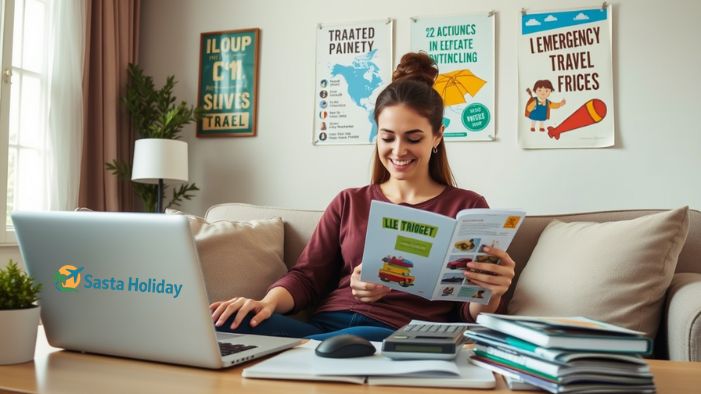Planning a trip should be fun. But sometimes, it feels like too much work. You have to book flights, find a place to stay, think about money, pack your bags, and more. It can get a little overwhelming.
That’s where a travel planner comes in. A good travel planner helps you organize everything in one place. You can feel more relaxed and enjoy your trip more.
In this guide, you’ll learn how to plan your trip from start to finish. We’ll walk you through every step to help make your travel smooth, fun, and stress-free.
Why a Travel Planner Is a Must-Have

Save Time and Worry Less
When you plan your trip ahead of time, you save a lot of time later. You won’t have to rush to find a hotel or figure out what to do when you get there.
A travel planner helps you:
-
Keep all your info in one place
-
Stay on top of your schedule
-
Avoid missing important steps
Stay on Budget
Travel can get expensive if you don’t plan it well. Using a travel planner helps you track your spending. You can plan your trip around what you can afford instead of overspending.
Feel Ready and Confident
When you plan ahead, you don’t have to worry about what might go wrong. You’ll know what to expect and what to do. That makes your trip a lot more fun.
How to Use a Travel Planner: Step-by-Step
Step 1: Pick Your Destination and Dates
Think about where you want to go. Do you want to relax on a beach? Explore a city? Try new foods?
Then decide when to go. Check the weather, holidays, and seasons. If you travel during busy times, things may cost more. If you go in the off-season, you might save money and avoid big crowds.
Tips:
-
Make a list of dream places
-
Use travel blogs or photos for ideas
-
Check if you need a visa or vaccines
Step 2: Plan Your Budget
Money matters when you travel. It’s important to know how much you want to spend.

Things to include in your budget:
-
Plane or train tickets
-
Hotels or places to stay
-
Food and drinks
-
Fun things to do (like tours or shows)
-
Transport (like taxis, buses, or rental cars)
-
Shopping and souvenirs
-
Emergency money (just in case)
Pro Tip: Always set aside a little extra money for surprises.
Step 3: Book Flights and Accommodation Early
Once you know where and when you’re going, book your flight and place to stay. Booking early usually means better prices and more choices.
Helpful ideas:
-
Compare prices on different websites
-
Look for places with free breakfast or Wi-Fi
-
Read reviews from other travelers
How to Plan a Great Travel Itinerary
An itinerary is your daily plan. It helps you use your time well and not miss anything important.
Start With Your “Must-Do” List
Make a list of things you really want to do. Maybe you want to see the Eiffel Tower, hike a mountain, or try local food. These go at the top of your list.
Then make a second list of things you might want to do if you have extra time.
Group Activities by Area
Use a map to plan your days. Try to visit places that are close to each other on the same day. This saves time and keeps things simple.
Example:
-
Day 1: Explore the old town and local market
-
Day 2: Visit two museums nearby
-
Day 3: Day trip to a nearby village
Use Tools to Stay Organized
Digital Tools You Can Use
Many free tools help with travel planning. You don’t need to be a tech expert.
Best ones to try:
-
Google Maps: Save places and directions
-
TripIt or Notion: Keep track of bookings
-
Google Sheets: Make your own planner
-
Offline maps: Great when you don’t have internet
Paper Tools Still Work Great
Some people still love using a notebook or printed planner. You can keep all your notes, tickets, and ideas in one place.
Packing Tips: Don’t Overpack or Forget
Packing the right way can make a big difference. A travel planner should include a packing list.
What to Pack for Every Trip
-
Clothes (check the weather first!)
-
Shoes (bring comfy ones)
-
Toiletries (toothbrush, shampoo, etc.)
-
Travel papers (passport, tickets, insurance)
-
Chargers and adapters
-
Water bottle
-
First-aid kit
-
Snacks for travel days
Pro Tip: Always bring a small bag for day trips.
Keep Your Trip Smooth While Traveling
Stay Flexible
Even the best plans can change. Maybe it rains. Maybe something is closed. That’s okay! Keep your travel planner close so you can adjust.
Backup Your Plans
Take photos of your tickets and ID. Save them online or email them to yourself. That way, you’ll still have them if you lose your bag or phone.
Read More:
Sasta Holiday: Your Cheapest Holiday Trip in 2025
Common Mistakes Travelers Make (and How to Avoid Them)
Many travelers make the same small mistakes. You can skip them with just a little planning.
-
Doing too much: Leave time to relax.
-
Not checking local rules: Some places have dress codes or customs to follow.
-
Skipping travel insurance: It’s better to be safe than sorry.
-
Not printing anything: Always carry paper copies of key info.
FAQs: Travel Planner Tips
Conclusion
Planning a trip can feel like a lot. But with the right travel planner, it becomes much easier. You can stay organized, avoid surprises, and have more fun.
Remember, a planner isn’t just for schedules. It helps you feel ready, stay on budget, and enjoy every part of your trip. Whether you’re going across the world or just across town, a little planning goes a long way.
So grab a notebook or open a travel app—and start dreaming!


